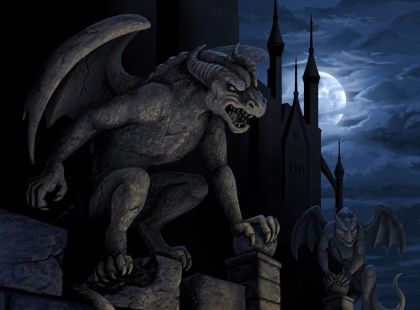Gargoyle
| Species | construct |
| No. Appearing | 1 |
| Behaviour | solitary |
| Range | subterranean, urban |
| Size | 4½–5 ft. tall |
| Weight | 3,600 to 4,800 lbs. |
| Intelligence | 5 |
| Armour Class | 0 |
| Hit Dice | 4+4 |
| Action Points | 6 |
| Max. Stride | {{{stride}}} |
| THAC0 | 18 |
| Hp/Die | d6+d8 |
| Attack Forms | 4: two claws; fangs; tail |
| Damage | 2–12 (claw); 2–16 (fangs); 4–10 (tail) |
| Special Attacks | impregnability, magic to hit |
Gargoyles are fantastical stone beings characterized by grotesque, frequently unsettling visages and classically gothic attributes. While a majority of these creatures possess wings, not all of them do. These enigmatic entities are typically encountered within dilapidated ruins and subterranean caves, and some even find their homes adorning cathedrals in the guise of statues. Their presence is exceedingly rare beyond the confines of Europe.
Contents
Their appearance can exhibit significant variation, primarily influenced by the artistic choices of their sculptors. Commonly, they feature elements reminiscent of dragons, serpents, lions, and bats. They lack the capacity for reproduction and are susceptible to the natural forces that can degrade, fracture, or even shatter rocks. With the exception of potential destruction, the exact duration of a gargoyle's existence remains a mystery, with the possibility that they could endure for ten or even twenty thousand years.
Origin
Gargoyles originated from mystical experiments conducted during the construction of the abbey at Cluny in the 11th century. The technique for crafting these peculiar creatures gradually spread over the subsequent three centuries. However, it was during the Papal Schism of 1378 to 1417 that gargoyles found themselves embroiled in conflict, aligning with different factions and, in some cases, gaining an unexpected form of self-awareness. While they were initially not particularly intelligent, these events led some gargoyles to develop a rudimentary consciousness and acting independently.
In 1417, the Council of Constance issued a decree banning the presence of gargoyles. Since that time, concerted efforts have been made to eliminate these beings. Nevertheless, gargoyles are not inherently malevolent or aggressive, but they have been easily manipulated by malevolent forces. As a result, the association with such negative influences has led to a widespread lack of empathy and trust towards these enigmatic creatures.
Behaviour
Because they are hunted, they will often hide in plain sight among ordinary, inanimate statuary, which they resemble. A gargoyle can remain absolutely still for as long as decades, so that an entire generation may presume that a gargoyle they've observed since childhood is nothing more than a statue. Often, town fathers or church leaders might deliberately overlook the appearance of a previously unseen gargoyle, adopting and protecting the creature rather than betraying its presence to gargoyle hunters.
Occasionally, packs of gargoyles are gathered together by exceptionally intelligent beings, who use the creatures towards their own ends. Gargoyles are susceptible to following command, and under the guidance of such a leader, they can be directed to carry out various tasks and objectives, often serving as a formidable force.
Advantages
The substantial weight of these creatures bestows upon them nearly twice number of hit points for a normal 4 hit dice creature. While the majority of gargoyles have the ability to take flight through magical means, their airborne agility is generally not particularly remarkable.
Impregnability. Gargoyles exhibit remarkable resistance to weaponry and boast colossal proportions, owing to their composition of animated stone, which is notably softer than natural stone but substantially harder than human flesh. Striking a gargoyle requires a roll to see if the used weapon breaks, just as it might if the weapon were fumbled.
Magic to Hit. Gargoyles are only hit by +1 magical weapons or better.
See Bestiary
